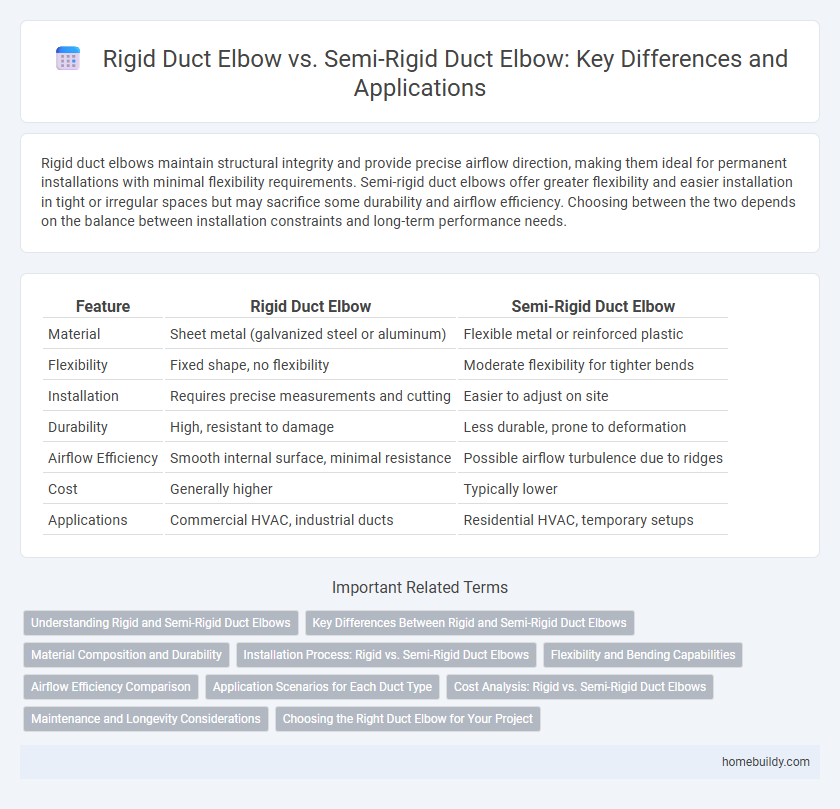Rigid duct elbows maintain structural integrity and provide precise airflow direction, making them ideal for permanent installations with minimal flexibility requirements. Semi-rigid duct elbows offer greater flexibility and easier installation in tight or irregular spaces but may sacrifice some durability and airflow efficiency. Choosing between the two depends on the balance between installation constraints and long-term performance needs.
Table of Comparison
| Feature | Rigid Duct Elbow | Semi-Rigid Duct Elbow |
|---|---|---|
| Material | Sheet metal (galvanized steel or aluminum) | Flexible metal or reinforced plastic |
| Flexibility | Fixed shape, no flexibility | Moderate flexibility for tighter bends |
| Installation | Requires precise measurements and cutting | Easier to adjust on site |
| Durability | High, resistant to damage | Less durable, prone to deformation |
| Airflow Efficiency | Smooth internal surface, minimal resistance | Possible airflow turbulence due to ridges |
| Cost | Generally higher | Typically lower |
| Applications | Commercial HVAC, industrial ducts | Residential HVAC, temporary setups |
Understanding Rigid and Semi-Rigid Duct Elbows
Rigid duct elbows provide superior structural integrity and maintain consistent airflow direction without deformation, making them ideal for high-pressure HVAC systems. Semi-rigid duct elbows offer flexibility and ease of installation in tight spaces but may experience slight airflow resistance due to potential bending. Understanding the trade-offs between rigidity and adaptability helps optimize duct system performance and durability.
Key Differences Between Rigid and Semi-Rigid Duct Elbows
Rigid duct elbows are made from solid materials such as sheet metal, offering superior durability, precise airflow control, and minimal pressure loss in HVAC systems. Semi-rigid duct elbows consist of flexible materials like aluminum or plastic with wire reinforcement, providing easier installation, better adaptability to tight spaces, and reduced noise transmission. Key differences include rigidity and structural strength, with rigid elbows maintaining shape under pressure, while semi-rigid elbows allow for slight deformation but offer greater flexibility in system design.
Material Composition and Durability
Rigid duct elbows are typically constructed from galvanized steel or aluminum, offering superior structural integrity and resistance to deformation under pressure. Semi-rigid duct elbows, made from flexible aluminum or insulated foil materials, provide moderate durability but are more prone to denting and wear over time. The choice between these depends on the application's demand for strength and longevity versus flexibility and ease of installation.
Installation Process: Rigid vs. Semi-Rigid Duct Elbows
Rigid duct elbows require precise measurements and secure fastening with screws or rivets, ensuring a stable, airtight fit ideal for fixed, straight duct runs. Semi-rigid duct elbows offer greater flexibility, allowing easier bending around obstacles and quicker installation, but may require additional sealing to prevent air leakage. Installation time for semi-rigid elbows is often shorter, while rigid elbows provide long-term durability in HVAC systems.
Flexibility and Bending Capabilities
Rigid duct elbows have limited flexibility due to their solid construction, making them ideal for maintaining fixed angles in HVAC systems but challenging to adjust once installed. Semi-rigid duct elbows offer enhanced bending capabilities, allowing easier manipulation and custom fitting around obstacles while still providing structural stability. Their increased flexibility reduces installation time and accommodates complex duct layouts more effectively than rigid elbows.
Airflow Efficiency Comparison
Rigid duct elbows offer superior airflow efficiency due to their smooth interior surfaces and precise angles that minimize turbulence and pressure loss. Semi-rigid duct elbows, while more flexible and easier to install in tight spaces, tend to create more airflow resistance because of their corrugated structure and less consistent shapes. The choice between rigid and semi-rigid elbows significantly impacts HVAC system performance, affecting energy consumption and air distribution quality.
Application Scenarios for Each Duct Type
Rigid duct elbows are ideal for commercial HVAC systems requiring durable, long-lasting connections that maintain airflow efficiency in large-scale installations. Semi-rigid duct elbows offer flexibility suited for residential or retrofit projects where space constraints and ease of installation are critical. Each type aligns with specific applications: rigid elbows excel in stable, high-performance environments, while semi-rigid elbows adapt well to complex layouts and limited access areas.
Cost Analysis: Rigid vs. Semi-Rigid Duct Elbows
Rigid duct elbows typically incur higher material and installation costs due to their solid construction and precise fittings, making them more durable and long-lasting. Semi-rigid duct elbows offer a cost-effective alternative with lower upfront expenses and easier handling but may require more frequent maintenance or replacement over time. Evaluating total lifecycle costs, including durability and maintenance, is essential for an accurate cost analysis between rigid and semi-rigid duct elbows.
Maintenance and Longevity Considerations
Rigid duct elbows offer superior durability with minimal maintenance requirements due to their solid construction that resists deformation and wear over time. Semi-rigid duct elbows, while easier to install and adjust, generally require more frequent inspections and maintenance to address potential leaks and structural fatigue. Longevity of rigid elbows typically surpasses semi-rigid types, making them a preferred choice for long-term HVAC system reliability.
Choosing the Right Duct Elbow for Your Project
Rigid duct elbows offer superior airflow control and durability, making them ideal for high-pressure HVAC systems and commercial installations. Semi-rigid duct elbows provide flexibility and ease of installation, suitable for residential projects or spaces with limited accessibility. Selecting the right duct elbow depends on project requirements such as airflow efficiency, installation complexity, and longevity needs.
Rigid duct elbow vs Semi-rigid duct elbow Infographic

 homebuildy.com
homebuildy.com